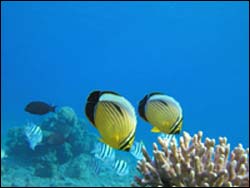Light-sensing protein illuminates sun-loving ocean bacteria

Ocean bacteria with the light-sensitive proteorhodopsin enzyme live several meters above this coral reef. (Photo: Boaz Harel)
About 13% of bacteria near the ocean’s surface contain proteorhodopsin, a membrane protein able to harness sunlight’s energy, according to a new study by Oded Beja and colleagues in the open-access journal PLoS Biology. Given the dearth of nutrients in their environment, these oligotrophic bacteria must generate their energy from a variety of sources. The study reveals that proteorhodopsin is uniquely suited to capturing the high-radiation sunlight that illuminates the sea. Through the use of meta-genomic analysis, the authors also observed great diversity among proteorhodopsin genes.
Estimating the average size of the bacterial genome led Beja and colleagues to the conclusion that about 13% of ocean bacteria encode proteorhodopsin. “This is a big chunk of the population that is harvesting light in a different way than photosynthesis,” says Beja. He added that his study “is the first to report fast photocycles with the so-called blue proteorhodopsins. This means both blue and green proteorhodopsins can act as proton pumps” to harvest energy because they contain proteorhodopsin. The authors also found some evidence suggesting that many of the bacteria with proteorhodopsin might be able to metabolize sulfur, a common energy source for deep-sea life. The marine bacteria might additionally be able to manufacture retinal, a molecule typically associated with vision.
The authors skimmed their bacteria samples from the top, or photic layer, of the Mediterranean and Red Seas. Since these bacteria can’t survive typical lab conditions, the scientists inserted large segments of collected ocean bacterial DNA into host bacteria to create an amplified collection of the genome known as a large-insert bacterial artificial chromosome (BAC) library. To detect the gene segments of interest, the scientists used “specially designed PCR primers that can detect almost all proteorhodopsins reported today,” Beja explains.
Many other organisms use proteins resembling proteorhodopsin for different functions. Humans, for instance, use rhodopsin to sense light in the eyeball. The presence of rhodopsin-like proteins in a wide range of life may eventually provide hints to the protein’s evolutionary age. That this large class of transmembrane proteins was so well-conserved over a long evolutionary time scale provides evidence for complex ancient proteins. The new study also raises the question of whether bacteria use proteorhodopsin solely for energy transduction or also for sensory input as humans use rhodopsin.
Media Contact
All latest news from the category: Life Sciences and Chemistry
Articles and reports from the Life Sciences and chemistry area deal with applied and basic research into modern biology, chemistry and human medicine.
Valuable information can be found on a range of life sciences fields including bacteriology, biochemistry, bionics, bioinformatics, biophysics, biotechnology, genetics, geobotany, human biology, marine biology, microbiology, molecular biology, cellular biology, zoology, bioinorganic chemistry, microchemistry and environmental chemistry.
Newest articles

Scientists transform blood into regenerative materials
… paving the way for personalized, blood-based, 3D-printed implants. Scientists have created a new ‘biocooperative’ material based on blood, which has shown to successfully repair bones, paving the way for…

A new experimental infection model in flies
…offers a fast and cost-effective way to test drugs. Researchers at the Germans Trias i Pujol Research Institute and Hospital have reinforced their leading role in infectious disease research by…

Material developed with novel stretching properties
KIT researchers produce metamaterial with different extension and compression properties than conventional materials. With this material, the working group headed by Professor Martin Wegener at KIT’s Institute of Applied Physics…



